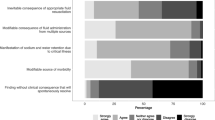Abstract
Objective
To assess the applicability of risk-adjusted sequential control charts using the Paediatric Index of Mortality version 2 for monitoring of the quality of paediatric intensive care.
Design
Observational study.
Setting
A registry of patient admissions to paediatric intensive care units (PICUs) in Australia and New Zealand.
Patients
A total of 10,710 patients admitted to eight PICUs during a 24-month period.
Measurements and results
A series of risk-adjusted control charts was created for each PICU. Modified sequential probability ratio tests were used to test the hypothesis that the PICUs being monitored were ‘out of control’, where loss of control was arbitrarily defined as the odds of death exceeding twice the odds of dying as estimated by PIM2. In 24 months of monitoring, there was one alarm signal, suggesting the odds of deaths had doubled, and there was one signal, in another PICU, suggesting the odds of death had halved.
Conclusions
The major advantage of risk-adjusted sequential control charts is that the technique allows unit performance to be monitored continuously over time, rather than intermittently, with the aim of rapidly detecting a change in performance as soon as possible after it occurs. This technique is suitable for continuously screening for a change in outcome within a PICU over time and complements other methods of monitoring the quality of paediatric intensive care.




Similar content being viewed by others
References
Barnard GA (1947) Sequential tests in industrial statistics. J R Stat Soc Suppl 8:1–26
Wald A (1945) Sequential tests of statistical hypotheses. Ann Math Stat 6:117–186
Williams SM, Parry BR, Schlup MMT (1992) Quality control: an application of the CUSUM. BMJ 304:1359–1361
de Leval MR, Francois K, Bull C, Brawn W, Spiegelhalter D (1994) Analysis of a cluster of surgical failures. Application to a series of neonatal arterial switch operations. J Thorac Cardiovasc Surg 107:914–924
Schlup MTM, Williams SM, Barbezat GO (1997) ERCP: a review of technical competency and workload in a small unit. Gastrointest Endosc 46:48–52
Lovegrove J, Valencia O, Treasure T, Sherlaw-Johnson C Gallivan S (1997) Monitoring the results of cardiac surgery by variable life-adjusted display. Lancet 350:1128–1130
Poloniecki J, Valencia O, Littlejohns P (1998) Cumulative risk adjusted mortality chart for detecting changes in death rate: observational study of heart surgery. BMJ 316:1697–1700
Lawrance RA, Dorsch MF, Sapsford RJ, Mackintosh AF, Greenwood DC, Jackson BM, Morrell C, Robinson MB, Hall AS (2001) Use of cumulative mortality data in patients with acute myocardial infarction for early detection of variation in clinical practice: observational study. BMJ 323:324–327
Rogers CA, Ganesh JS, Banner NR, Bonser RS (2005) Steering Group Cumulative risk adjusted monitoring of 30-day mortality after cardiothoracic transplantation: UK experience. Eur J Cardiothorac Surg 27:1022–1029
Axelrod DA, Guidinger MK, Metzger RA, Wiesner RH, Webb RL, Merion RM (2006) Transplant center quality assessment using a continuously updatable, risk-adjusted technique (CUSUM). Am J Transplant 6:313–323
Cook DA, Steiner SH, Cook RJ, Farewell VT, Morton AP (2003) Monitoring the evolutionary process of quality: risk-adjusted charting to track outcomes in intensive care. Crit Care Med 31:1676–1682
Parsonnet V, Dean D, Bernstein AD (1989) A method of uniform stratification of risk for evaluating the results of surgery in acquired adult heart disease. Circulation 79 [Suppl I]:I3–I12
Steiner SH, Cook RJ, Farewell VT, Treasure T (2000) Monitoring surgical performance using risk-adjusted cumulative sum charts. Biostatistics 1:441–452
Slater A, Shann F, Pearson G, Paediatric Index of Mortality (PIM) Study Group (2003) PIM2: a revised version of the Paediatric Index of Mortality. Intensive Care Med 29:278–285
Spiegelhalter D, Grigg O, Kinsman R, Treasure T (2003) Risk-adjusted sequential probability ratio tests: applications to Bristol, Shipman and adult cardiac surgery. Int J Qual Health Care 15:7–13
Grigg OA, Farewell VT, Spiegelhalter DJ (2003) Use of risk-adjusted CUSUM and RSPRT charts for monitoring in medical contexts. Stat Methods Med Res 12:147–170
Marshall EC, Spiegelhalter DJ (1998) Reliability of league tables of in vitro fertilisation clinics: retrospective analysis of live birth rates. BMJ 316:1701–1705
Adab P, Rouse AM, Mohammed MA, Marshall T (2002) Performance league tables: the NHS deserves better. BMJ 324:95–98
Goldstein H, Spiegelhalter DJ (1996) League tables and their limitations: statistical issues in comparisons of institutional performance. J R Stat Soc A 159:385–443
Spiegelhalter DJ (2005) Funnel plots for comparing institutional performance. Stat Med 24:1185–1202
Brady AR, Harrison D, Black S, Jones S, Rowan K, Pearson G, Ratcliffe J, Parry GJ on behalf of the UK PICOS Study Group (2006) Assessment and optimization of mortality prediction tools for admissions to pediatric intensive care in the United Kingdom. Pediatrics 117:e733–e742
Pollack MM, Ruttimann UE, Getson PR (1988) Pediatric risk of mortality (PRISM) score. Crit Care Med 16:1110–1116
Shann F, Pearson G, Slater A, Wilkinson K (1997) Paediatric index of mortality (PIM): a mortality prediction model for children in intensive care. Intensive Care Med 23:201–207
Acknowledgements
The ANZPIC Registry is supported by the Australian and New Zealand Intensive Care Society, the Ministry of Health (New Zealand), and State and Territory Health Departments through the Australian Health Ministers' Advisory Council. The ANZICS Paediatric Study Group members who contributed to this report include: B. Wilkins, A. Morrison, Children's Hospital at Westmead; B. Lister, P. Sargent, A. Barlow, Mater Children's Hospital, Brisbane; A. Duncan, Princess Margaret Hospital, Perth; J. McEniery, A. Slater, Royal Children's Hospital, Brisbane; F. Shann, C. Delzoppo, Royal Children's Hospital, Melbourne; B. Duffy, J. Young, Sydney Children's Hospital; M. Yung, R. Bradley, L. Norton, Women's and Children's Hospital, Adelaide; E. Segedin, D. Buckley, Starship Hospital, Auckland. We thank the many nurses, physicians, research officers and secretaries who collected, entered and cleaned the data.
Author information
Authors and Affiliations
Consortia
Corresponding author
Electronic supplementary material
Rights and permissions
About this article
Cite this article
Baghurst, P.A., Norton, L., Slater, A. et al. The application of risk-adjusted control charts using the Paediatric Index of Mortality 2 for monitoring paediatric intensive care performance in Australia and New Zealand. Intensive Care Med 34, 1281–1288 (2008). https://doi.org/10.1007/s00134-008-1081-0
Received:
Accepted:
Published:
Issue Date:
DOI: https://doi.org/10.1007/s00134-008-1081-0




